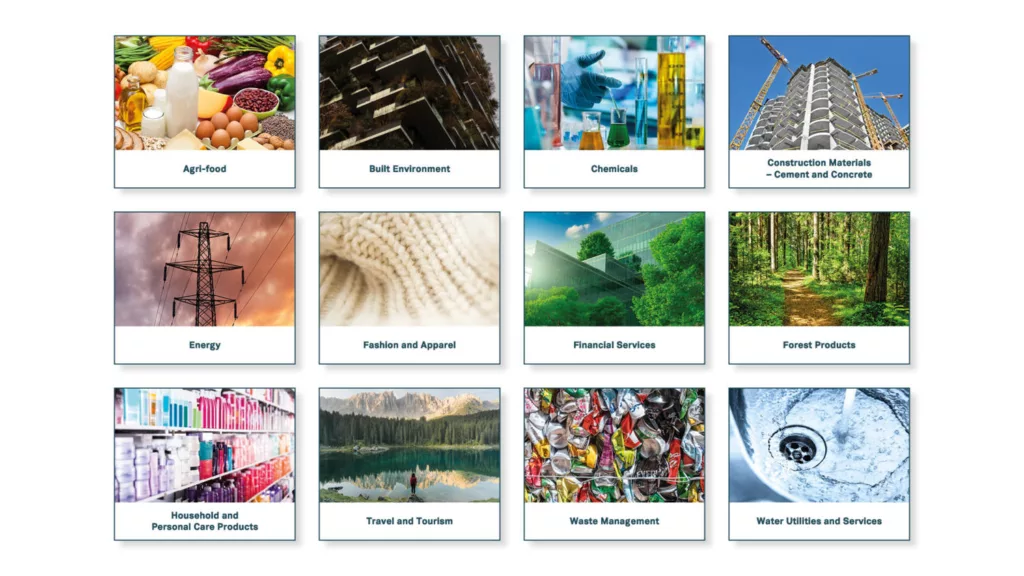Authors
Diane Holdorf, Executive Vice President, WBCSD, Akanksha Khatri, Head, Nature and Biodiversity, World Economic Forum, Eva Zabey, CEO, Business for Nature
This article originally appeared on the WEF website under the following link: The race to a nature-positive future: What every sector needs to do | World Economic Forum (weforum.org)
- The Kunming-Montreal Global Biodiversity Framework charts a new course for our society’s relationship with nature, with business action critical to the mission of halting and reversing nature loss by 2030.
- A sectoral approach is needed to address the impacts and dependencies that different parts of the economy have on nature and biodiversity.
- To help accelerate the transition to a nature-positive future, new guidance sets out the priority actions to be taken by all businesses across 12 sectors.
Last December, the world took an important step towards resetting its relationship with nature. Amidst unparalleled biodiversity loss and a worsening climate emergency, the Kunming-Montreal Global Biodiversity Framework (GBF) agreed last year by 196 governments set out the range and scale of actions needed for the world to halt and reverse nature loss by 2030 – a goal commonly referred to as ‘nature positive’.
Notably, the framework calls out the role of business in contributing towards a nature-positive world in several of its goals and targets. This comes as more and more business leaders seek to understand the full extent of the risks that the nature crisis presents to their companies.
These range from disruption of their operations and supply chains resulting from the loss of nature and ecosystem services to transitional risks resulting from shifting customer expectations, and investor pressure and new regulation for nature-related reporting and disclosure.
All in all, it is increasingly clear that companies willing to lead the transformation and act now on nature will be better placed not only to mitigate their nature-related risks, meet shifting societal expectations and prepare for upcoming regulation, but also to tap into the commercial opportunities that come from protecting and restoring nature.
Accelerating corporate action on nature
The scale of business impact on nature is clear, with the operations of four major value chains – food, energy, infrastructure, and fashion – currently driving more than 90% of man-made pressure on biodiversity.
While some businesses have started to explore and reduce their impacts and dependencies on biodiversity, corporate action on nature lags far behind climate action. Research shows that 83% of Fortune Global 500 companies have targets to address climate change, compared to only 5% for biodiversity loss.
Addressing climate change effectively will be impossible without protecting, restoring and responsibly managing our natural world.
According to the Intergovernmental Panel on Climate Change (IPCC), over the past 10 years, our planet’s oceans, flora, fauna and soils have absorbed more than 50% of human-induced carbon emissions. Studies also show that nature-based solutions can provide up to 37% of the emissions reduction needed by 2030 to keep global temperature increases under 2ºC.
Nature is our best ally against a global climate catastrophe. Now is the time for business to take action to help build a future that is nature positive as well as net zero.
Why companies need a sector-specific approach
All parts of our economy are dependent on nature and its ecosystem services to continue functioning. Even though every sector relies on nature throughout its value chain, they simultaneously continue to contribute to the very drivers of nature’s decline.
- The chemical sector accounts for 5-10% of freshwater use globally, yet is dependent on freshwater stocks to continue operating.
- The personal care and household product sector relies on commodities and natural ingredients, yet some sourcing practices for harvesting plants have a direct impact on biodiversity.
- Global food production relies on biodiversity and healthy ecosystems, yet agriculture is an identified threat to 86% of species at risk of extinction.
Put simply, a nature-positive future is unattainable without reducing our impacts on nature and reversing nature loss. This requires a rapid transformation of our socio-economic systems.
To take nature-positive action at the scale and speed necessary, it is crucial for businesses to understand their specific interactions with nature in the context of the sector in which they operate.
This will allow them to take the most effective steps to minimize their impacts and dependencies on nature and to identify the opportunities to collaborate on, or advocate for, accelerated change.
Priority actions to transform 12 global sectors
To help inform these sectoral approaches, Business for Nature, the World Business Council for Sustainable Development and the World Economic Forum have, with the support of many partner organizations produced new guidance on the sector-specific actions companies can take for 12 global sectors to transform their operations and value chains:

The 12 sectors comprise agri-food, built environment, chemicals, construction materials – cement and concrete, energy, fashion and apparel, financial services, forest products, household and personal care products, travel and tourism, waste management, and water utilities and services.
For each sector, high-level actions have been identified that all businesses can take, linking to global tools such as the Science-based Target Network (SBTN) guidance and the risk management and disclosure framework developed by the Taskforce on Nature-related Financial Disclosure (TNFD).
Examples include:
- Energy businesses can adopt circular designs and incorporate recycled materials in turbines.
- Household and personal care product companies can increase investment into nature-conscious products and business models, such as refillable products, waterless formulations, and reusable or durable products to minimize water consumption and pollution of water systems.
- Cement and concrete businesses can replace freshwater with non-freshwater sources such as harvested rainwater or treated municipal water, establish water recycling systems, and create artificial wetlands to reduce water withdrawal and improve water quality.
- Agri-food companies can avoid the degradation – and accelerate the regeneration – of land and ecosystems by committing to and implementing deforestation and conversion-free production and/or sourcing and supporting farmers to embed regenerative agricultural practices.
The recommended transformative actions follow the commonly used mitigation hierarchy to first avoid and reduce pressures on nature, then restore and regenerate to recover the state of nature, and finally to transform underlying systems to address the drivers of nature loss.
Putting nature first benefits everyone
It is abundantly clear that putting nature first is necessary to promote the health of our planet and ensure a resilient and sustainable future for us all.
Nature is our best ally in helping achieve climate goals, securing a thriving economy and society, and it is the responsibility of businesses of all sizes, geographies, and sectors to play their part.
It will require investment and innovation but the sector-specific actions on nature offer a roadmap towards this transformation.
Outline
